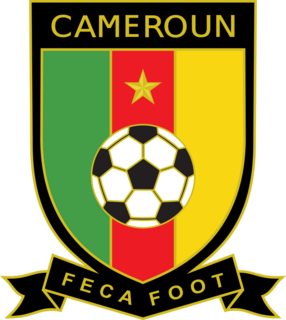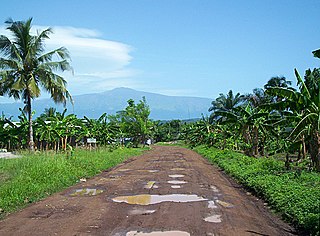Related Research Articles

Cameroon, officially the Republic of Cameroon, is a country in west-central Africa. It is bordered by Nigeria to the west and north; Chad to the northeast; the Central African Republic to the east; and Equatorial Guinea, Gabon and the Republic of the Congo to the south. Its coastline lies on the Bight of Biafra, part of the Gulf of Guinea and the Atlantic Ocean. The country is sometimes identified as West African and other times as Central African, due to its strategic position at the crossroads between West and Central Africa. Its nearly 25 million people speak 250 native languages.
Makossa is a Cameroonian style of urban music. Like much other late 20th century music of Sub-Saharan Africa, it uses strong electric bass rhythms and prominent brass. In the 1980s makossa had a wave of mainstream success across Africa and to a lesser extent abroad.

The music of the Cameroon includes diverse traditional and modern musical genres. The best-known contemporary genre is makossa, a popular style that has gained fans across Africa, and its related dance craze bikutsi.

The Cameroon national football team represents Cameroon in men's international football and It is controlled by the Fédération Camerounaise de Football. The team has qualified eight times for the FIFA World Cup, more than any other African team (in 1982, 1990, 1994, 1998, 2002, 2010 and 2014. However, the team has only made it once out of the group stage. They were the first African team to reach the quarter-final of the FIFA World Cup in 1990, losing to England in extra time. They have also won five Africa Cup of Nations and Olympic gold in 2000. The team represents Cameroon both in FIFA and Confederation of African Football.
Bend-skin is a kind of urban Cameroonian popular music. Kouchouam Mbada is the best known group associated with the genre. Several other artists have over the years contributed to the growth and popularity of bend skin. It is related to mangambeu, and is played using only drums and maracas, with a vocalist who both sings and raps. It is often sung in Medumba which is the language of the Bangangte people and in many other Bamileke dialects.

Tiko, originally called ‘Keka’ by the Bakweris, is a town and important port in the southwest region of Cameroon. The settlement grew as a market town for Duala fishermen, Bakweri farmers and hunters from Molyko, Bwenga, Bulu and Bokova. The core quarters in Tiko include Streets 1 to 7, Motombolombo, Down Beach, New Quarter, P&T quarters, New Layout, Long Street, Likomba, Golf Club, Mutengene, Ombe. As of 2010, the town is estimated to have a population of 55,914.

The Kirdi are the many cultures and ethnic groups who inhabit northwestern Cameroon and northeastern Nigeria.
Waka music is a popular Islamic-oriented Yoruba musical genre. It was made popular by Alhaja Batile Alake from Ijebu, who took the genre into the mainstream Nigerian music by playing it at concerts and parties; also, she was the first waka singer to record an album. Later, younger singers like Salawa Abeni and Kuburatu Alaragbo joined the pack. In 1992, Salawa Abeni was crowned "Queen of Waka" by the Alafin of Oyo, Oba Lamidi Adeyemi.

Bamum, also spelled Bamun or in its French spelling Bamoun, is an Eastern Grassfields language of Cameroon, with approximately 420,000 speakers. The language is well known for its original script developed by King Njoya and his palace circle in the Kingdom of Bamum around 1895. Cameroonian musician Claude Ndam was a native speaker of the language and sang it in his music.

Ancistrocladus is a genus of woody lianas in the monotypic family Ancistrocladaceae. The branches climb by twining other stems or by scrambling with hooked tips. They are found in the tropics of the Old World.

The algaita is a double reed wind instrument from West Africa, especially among the Hausa and Kanuri peoples. Its construction is similar to the oboe-like rhaita and the zurna. The algaita is distinguished from these other instruments by its larger, trumpet-like bell. Instead of keys, it has open holes for fingering, similar to the zurna.
Ambasse bey or ambas-i-bay is a style of folk music and dance from Cameroon. The music is based on commonly available instruments, especially guitar, with percussion provided by sticks and bottles. The music is faster-paced than assiko.

Dance in Cameroon is an integral part of the tradition, religion, and socialising of the country's people. Cameroon has more than 200 traditional dances, each associated with a different event or situation. Colonial authorities and Christian missionaries discouraged native dances as threats to security and pagan holdovers. However, after Cameroon's independence, the government recognised traditional dance as part of the nation's culture and made moves to preserve it.

Turraeanthus africanus is a species of plant in the family Meliaceae, also known by the common names avodiré, apeya, engan, agbe, lusamba, wansenwa, African satinwood, and African white mahogany.

Bata (Gbwata) is an Afro-Asiatic language spoken in Nigeria in Adamawa State in the Numan, Song, Fufore and Mubi LGAs, and in Cameroon in North Province along the border with Nigeria. Dialects are Demsa, Garoua, Jirai, Kobotachi, Malabu, Ndeewe, Ribaw, Wadi, and Zumu (Jimo). It is often considered the same language as Bacama.

The Cameroonian Football Federation is the governing body of football in Cameroon. It is known as FECAFOOT.
The Koma language is a language cluster belonging to the Duru branch of Savannas languages of Cameroon. Blench (2004) includes three varieties separated in Ethnologue, Koma Ndera, Gɨmne, and Gɨmnɨme; within Koma Ndera, speakers of the marginal dialects, Gomnome and Ndera, can scarcely understand one another, though both understand the central dialect, Gomme.
Wandala, also known as Mandara or Mura', is a language in the Chadic branch of the Afro-Asiatic language family, spoken in Cameroon and Nigeria.
Bangando and Ngombe constitute a Gbaya language of Cameroon and CAR.

The High Commission for the Republic of Cameroon in London is the diplomatic mission of Cameroon in the United Kingdom.
References
- Nkolo, Jean-Victor, and Graeme Ewens (2000). "Cameroon: Music of a Small Continent". World Music, Volume 1: Africa, Europe and the Middle East. London: Rough Guides Ltd., p. 445.